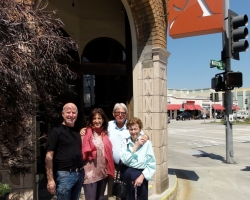
History happens. And if we are lucky, sites and/or structures are recognized by preservationists with plaques to signify their importance. Such is the case of the Hull Building in downtown Culver City. A while back a visitor chanced upon the historical society’s plaque on the building, took a picture of it and sent it to his friend, Foster Hull, the son of Nebraska-born Dr. Foster Hull (born in 1897), who received his medical degree from the University of Southern California and subsequently served as an Army captain in World War I.
Hull rode through France as a medical officer during his service, and then moved to Culver City in 1919. He lived near the hospital he was destined to build. His practice included caring for locals – some of whom paid in lima beans or goats – as well as silent film legends Tom and Harry Brown, and the family of Myrna Loy.
Hull married Marion Dunlop in 1928. Their son Foster was born in 1930 in Culver City. The Hulls moved to Hollywood in the 1930s, after losing the Hull Building during the Great Depression. They later moved to a home in Laurel Canyon. Dr. Hull invented an antiseptic seaweed product called Pyogon, used in China in the 1930s for dental purposes, according to his son. Hull passed away in 1948.
Dr. Hull had two brothers and a sister. His brothers settled in the San Fernando Valley, raised horses and had a lumber business on Melrose Avenue in Hollywood.
When asked about his father, Foster’s memories included his father’s love of music and singing. He had fond memories of horseback riding with his father. In fact, when Foster moved to Maui in 1972, he established stables called Rainbow Ranch.
The Hull Building, which we know as Akasha restaurant today, was constructed as the first hospital in Culver City. Dr. Hull, a physician/surgeon who served the city as its second health officer, built the structure in 1925. The Culver City Historical Society marked it as Historic Site #2 in the early 1980s. When historic preservation was added to the municipal code in 1991, the building earned landmark status.
The wedge-shaped Neo-classical style building was purchased by Louis Freeman during the Great Depression. The tan-and-rose-colored brick structure has remained in the ownership of the Freeman family for three generations. The first floor housed many businesses, including Sunset Drugs (which had a soda fountain), Al Simon’s Sada’s Flowers (1930s), Ed Tinger’s Culver City Flowers (1940s), Kamin’s Shoes, and in 1978, the Bank of Orange County, which gutted the building and brought it up to earthquake standards. More recently, it was reconfigured to become a restaurant, (Riccardo’s, Bella Pasta, San Gennaro and now Akasha). The upstairs housed offices and a boarding house at one time.
To come full circle, Culver City Historical Society president Stu Freeman (grandson of Louis Freeman) recently talked to Foster Hull and arranged for him to dine at Akasha during his visit last week.
